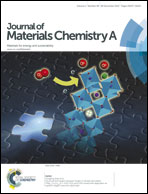Influence of linker molecules on interfacial electron transfer and photovoltaic performance of quantum dot sensitized solar cells†
Abstract
The charge transfer rate between QD sensitizer/TiO2 interfaces in quantum dot sensitized solar cells (QDSCs) is one of the most important criteria determining the photovoltaic performance of cells. To investigate the influence of linker molecules on the electron transfer rate at the QD–linker–TiO2 interface and the final performance of the resultant QDSCs, colloidal QDs capped with thioglycolic acid (TGA), 3-mercaptopropionic acid (MPA), and cysteine (Cys), which also serve as molecular linkers between QDs and TiO2 nanoparticles, were self-assembled on a TiO2 mesoporous film electrode from the corresponding QD aqueous dispersions. The influence of the studied linker molecules (TGA, MPA, and Cys) on the loading amount of QD sensitizer on the TiO2 mesoporous film, the electron injection rate from QDs to the TiO2 matrix, the incident photon to charge carrier generation efficiency (IPCE), and the corresponding photovoltaic performance of the resultant QDSCs were systematically studied. CdSe and CdSexTe1−x QD sensitized solar cells were selected as a model cell to evaluate the influence of the adopted linker molecules. Under AM 1.5G full one sun intensity illumination, the power conversion efficiency (PCE) of TGA-capped QDs (5.40% for CdSe, and 6.68% for CdSexTe1−x) was 7–14% greater than those of MPA- and Cys-capped QDs. Similarly, the absorbed photon-to-current efficiency was 8–13% greater. These differences arise from linker molecule-dependent variations of the electron-injection rate. Transient grating measurements indicate that the electron injection rate constant from TGA-capped CdSe (8.0 × 109 s−1) was greater than from MPA- and Cys-capped CdSe (2.6–2.9 × 109 s−1). Thus, TGA-capped QDs are readily attached to the TiO2 substrate and exhibit better electronic properties and desirable electron-transfer rate, and therefore bring forward better photovoltaic performance in the resultant solar cells.


 Please wait while we load your content...
Please wait while we load your content...